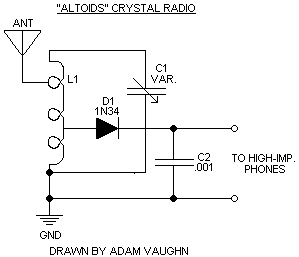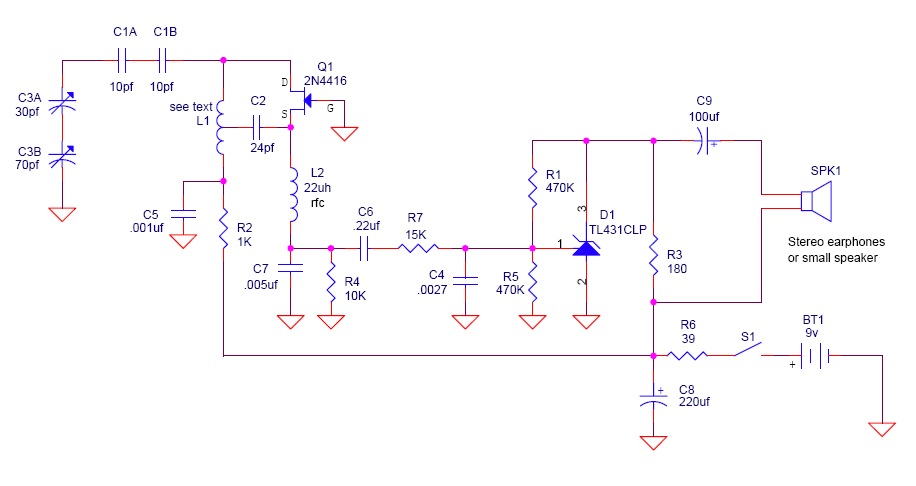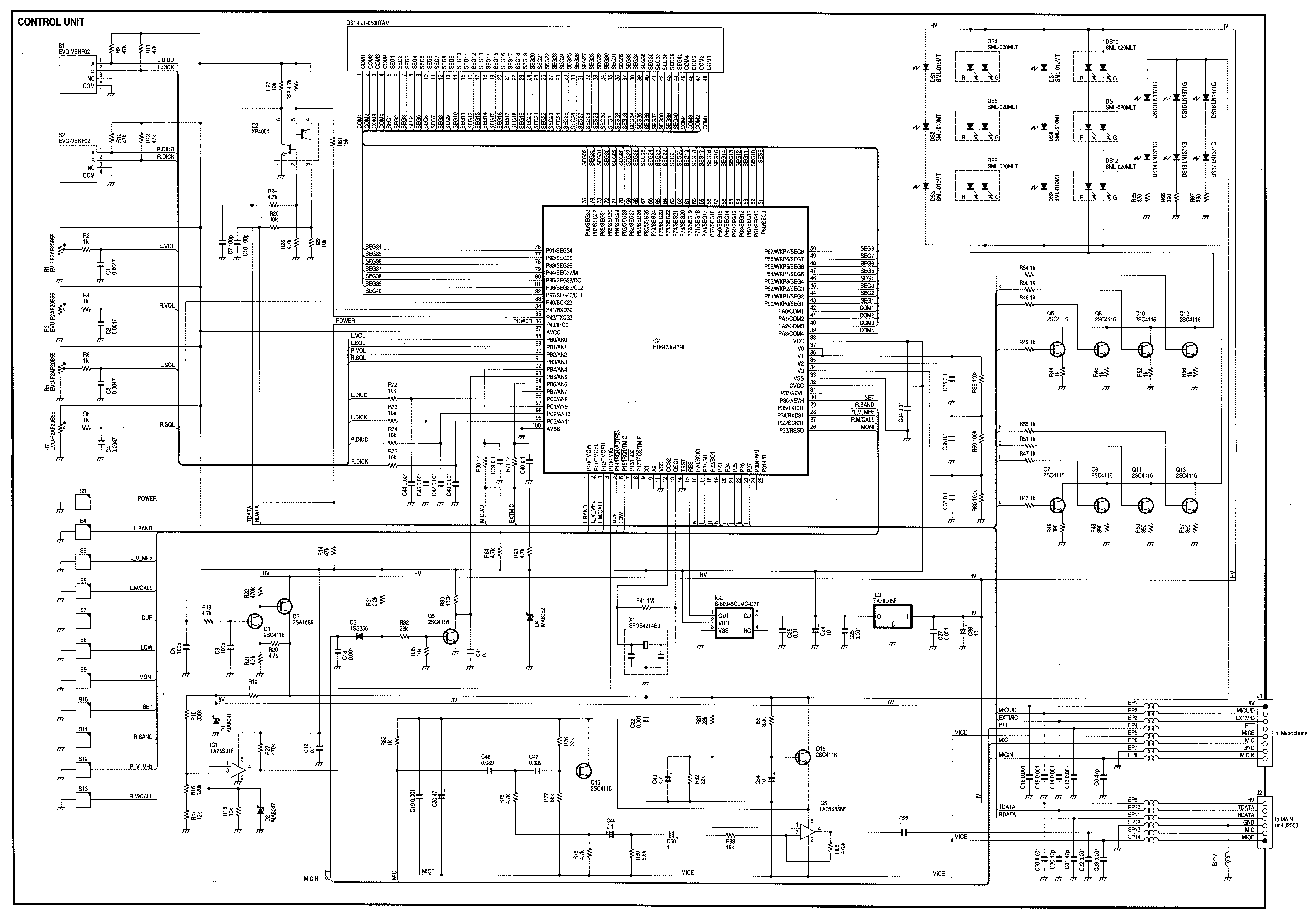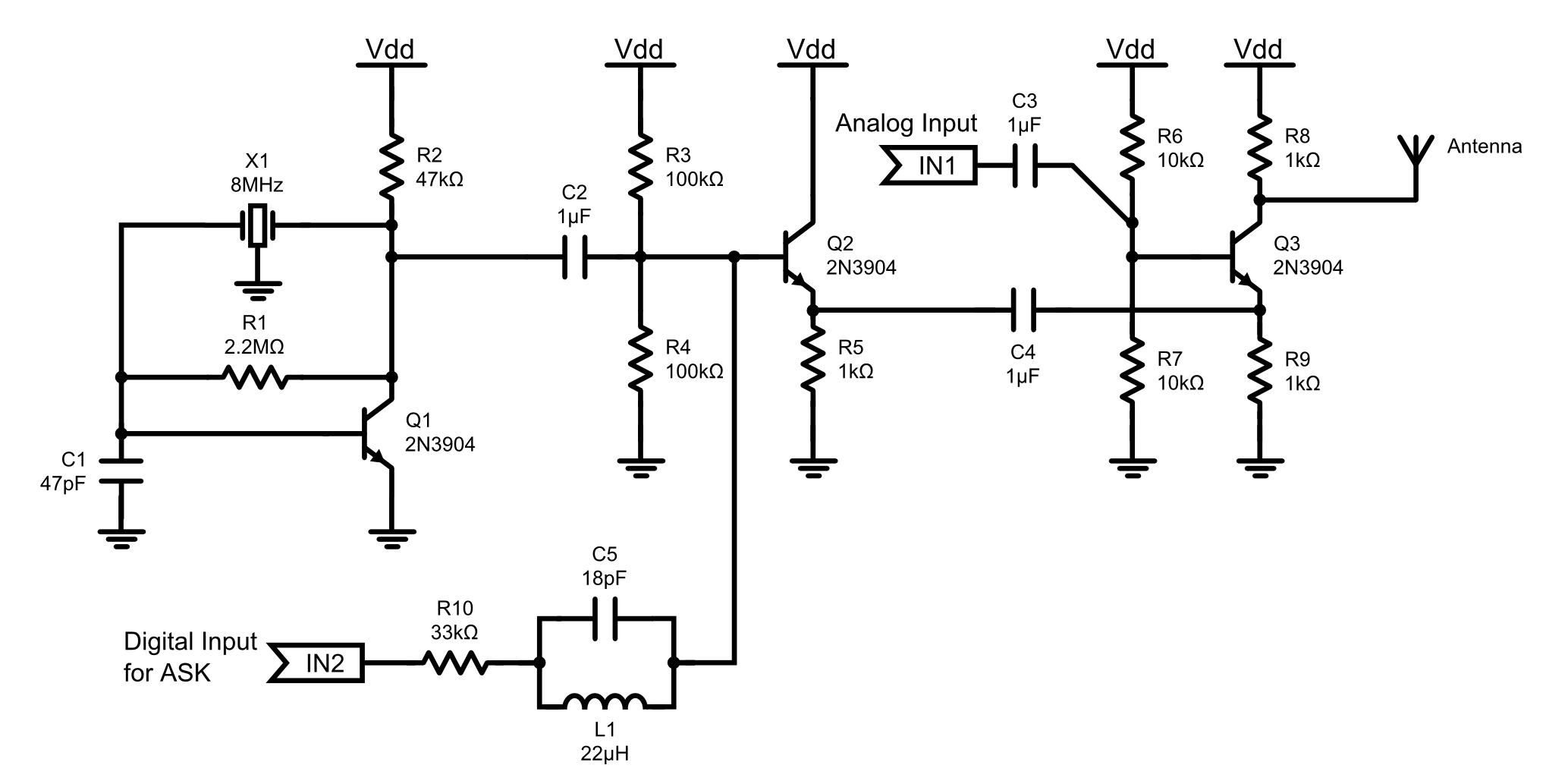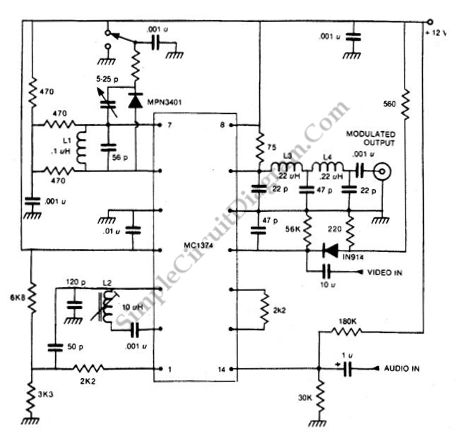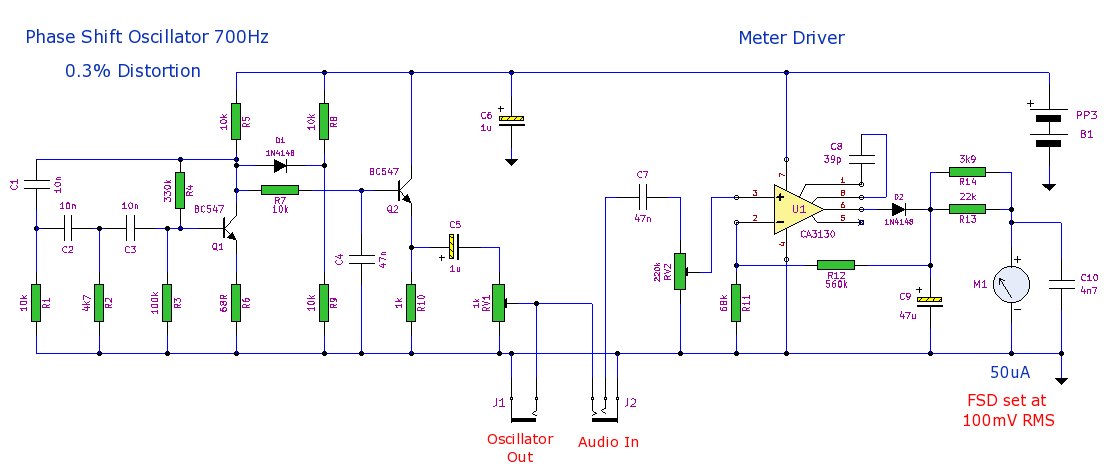
Small Radio Transmitters
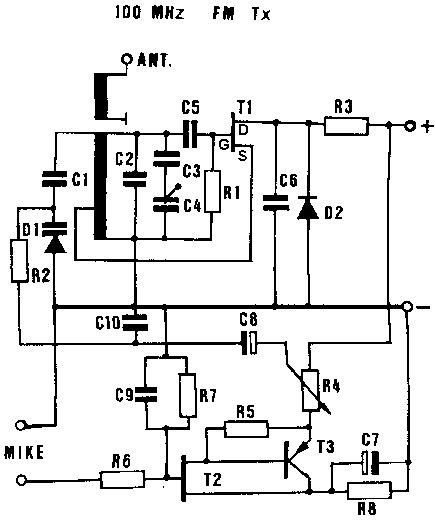
Information about building a small radio transmitter, which has a PCB measuring 1.75" x 2.5" (45mm x 68mm) and has a range of approximately 30 yards. The documentation states that the frequency range is 100-108 MHz, but it has been observed to be more like 85-100 MHz. The circuit operates in mono and accepts audio input from either a microphone or another source. The input impedance is 1 MΩ, with an input sensitivity of 5 mV and a maximum input signal of 10 mV. The transmitted signal can be received on an FM radio. This circuit is suitable for short-range transmission, such as for wireless microphones. The original circuit is available as a kit from Velleman Electronics (USA distributor: Tapto Corp., PO Box 1339, Claremont, NH 03743, US; UK distributor: High-Q Electronics, 382 Edgware Road, London, W2 1EB) under kit number K1771. It is recognized as a highly effective transmitter. A personal experience indicates that a home-made version of the circuit, built from a self-designed PCB, performed even better than the original kit. Therefore, purchasing the kit may not be necessary, as the circuit is relatively simple and represents an excellent example of a home-made transmitter. The PCB layout is depicted in PCBPLAN.GIF, which accurately shows the component arrangement from above. PCBPLAN.GIF is derived from the instruction sheet. A reference point is marked in one corner. TRACKS.GIF illustrates the track layout on the soldering side of the board, although it is not an accurate representation due to the lack of a formal track layout plan. To create TRACKS.GIF, a piece of OHP film was placed on the bottom of the PCB, and the tracks were traced with an OHP pen before being scanned. Component leg holes are approximately indicated with white blobs. It is advised to use PCBPLAN.GIF for precise hole drilling in the PCB, while TRACKS.GIF serves as a guide for drawing the tracks. It is crucial to accurately draw the printed coil on the PCB, as its design is integral to the circuit's functionality.
The small radio transmitter circuit is designed for efficient short-range audio transmission, making it ideal for applications like wireless microphones. The PCB dimensions of 1.75" x 2.5" facilitate compact integration into various enclosures or devices. The circuit operates within a frequency range that, while documented as 100-108 MHz, has been found to function effectively between 85-100 MHz, which may provide additional flexibility depending on local transmission regulations and receiver compatibility.
The input stage of the circuit, with a high impedance of 1 MΩ, allows for the connection of various audio sources without significant loading effects, ensuring high fidelity of the transmitted audio signal. The input sensitivity of 5 mV and the maximum input signal of 10 mV indicate that the circuit can handle standard microphone outputs and line-level signals, making it versatile for different audio applications.
The transmitter's mono output is suitable for basic audio transmission needs, and the ability to receive the signal on standard FM radios enhances its practicality for users. The kit form of the transmitter not only provides a learning opportunity for individuals interested in electronics but also allows for customization and experimentation with the design.
The PCB layout provided in PCBPLAN.GIF is critical for ensuring correct component placement and soldering, while TRACKS.GIF serves as a useful reference for replicating the track layout. Attention to detail in the construction process, especially regarding the printed coil, is essential for maintaining the integrity of the transmitter's performance. Overall, this small radio transmitter represents an accessible project for hobbyists and engineers alike, offering a balance of simplicity and functionality.Information about building a small radio transmitter, which has a PCB 1. 75" x 2. 5" (45mm x 68 mm) and has a range of about 30 yards or so. The documentation with the circuit says the freq range is 100-108 MHz, but I have found it to be more like 85-100 MHz. The circuit is (of course) only mono, and accepts an audio input from either a mic rophone or other source. The input impedance is 1Mohm. The input sensitivity is 5mV and the max input signal is 10mV. The transmitted signal can be picked up on a FM radio. The circuit can be used for short-range transmission, eg. for wireless microphones. The actual circuit comes from a `Kit`, available from Veleman electronics (USA distributor is Tapto Corp. , PO Box 1339, CLAREMONT NH-03743-US. UK distributor is High-Q Electronics, 382 Edgware Road, London, W2 1EB). The kit number is K1771. It is a very good transmitter. I bought the kit, and made the circuit, which worked very well. I wanted two transmitters, so I made my own `copy` PCB and built the circuit, and in fact my home-made version seems to work better than the original!
So there is no need to buy the kit really, as it is quite a simple circuit, and is the best `home-made` transmitter I have seen. PCBPLAN. GIF shows the PCB layout from above (components shown). PCBPLAN. GIF is an accurate layout, scanned from the instruction sheet. I have used * to mark one corner for reference. TRACKS. GIF shows the track layout on the soldering side of the board. This is NOT a very accurate layout. This is because I didn`t actually have a plan of the track layout. To get TRACKS. GIF, I put a bit of OHP film onto the bottom of the PCB, and traced the tracks with an OHP pen. I then scanned this in. I have marked the component leg holes (approximately) with white blobs. Then make your PCB. As mentioned earlier, PCBPLAN. GIF gives the accurate positioning of the holes, whereas TRACKS. GIF gives the positions only approximately. So use PCBPLAN when drilling the holes in your PCB board. Then draw on the tracks, using TRACKS. GIF as a guide. The important thing is to make sure you draw the `printed coil` correctly on the PCB - those lines are there for a reason!
🔗 External reference
The small radio transmitter circuit is designed for efficient short-range audio transmission, making it ideal for applications like wireless microphones. The PCB dimensions of 1.75" x 2.5" facilitate compact integration into various enclosures or devices. The circuit operates within a frequency range that, while documented as 100-108 MHz, has been found to function effectively between 85-100 MHz, which may provide additional flexibility depending on local transmission regulations and receiver compatibility.
The input stage of the circuit, with a high impedance of 1 MΩ, allows for the connection of various audio sources without significant loading effects, ensuring high fidelity of the transmitted audio signal. The input sensitivity of 5 mV and the maximum input signal of 10 mV indicate that the circuit can handle standard microphone outputs and line-level signals, making it versatile for different audio applications.
The transmitter's mono output is suitable for basic audio transmission needs, and the ability to receive the signal on standard FM radios enhances its practicality for users. The kit form of the transmitter not only provides a learning opportunity for individuals interested in electronics but also allows for customization and experimentation with the design.
The PCB layout provided in PCBPLAN.GIF is critical for ensuring correct component placement and soldering, while TRACKS.GIF serves as a useful reference for replicating the track layout. Attention to detail in the construction process, especially regarding the printed coil, is essential for maintaining the integrity of the transmitter's performance. Overall, this small radio transmitter represents an accessible project for hobbyists and engineers alike, offering a balance of simplicity and functionality.Information about building a small radio transmitter, which has a PCB 1. 75" x 2. 5" (45mm x 68 mm) and has a range of about 30 yards or so. The documentation with the circuit says the freq range is 100-108 MHz, but I have found it to be more like 85-100 MHz. The circuit is (of course) only mono, and accepts an audio input from either a mic rophone or other source. The input impedance is 1Mohm. The input sensitivity is 5mV and the max input signal is 10mV. The transmitted signal can be picked up on a FM radio. The circuit can be used for short-range transmission, eg. for wireless microphones. The actual circuit comes from a `Kit`, available from Veleman electronics (USA distributor is Tapto Corp. , PO Box 1339, CLAREMONT NH-03743-US. UK distributor is High-Q Electronics, 382 Edgware Road, London, W2 1EB). The kit number is K1771. It is a very good transmitter. I bought the kit, and made the circuit, which worked very well. I wanted two transmitters, so I made my own `copy` PCB and built the circuit, and in fact my home-made version seems to work better than the original!
So there is no need to buy the kit really, as it is quite a simple circuit, and is the best `home-made` transmitter I have seen. PCBPLAN. GIF shows the PCB layout from above (components shown). PCBPLAN. GIF is an accurate layout, scanned from the instruction sheet. I have used * to mark one corner for reference. TRACKS. GIF shows the track layout on the soldering side of the board. This is NOT a very accurate layout. This is because I didn`t actually have a plan of the track layout. To get TRACKS. GIF, I put a bit of OHP film onto the bottom of the PCB, and traced the tracks with an OHP pen. I then scanned this in. I have marked the component leg holes (approximately) with white blobs. Then make your PCB. As mentioned earlier, PCBPLAN. GIF gives the accurate positioning of the holes, whereas TRACKS. GIF gives the positions only approximately. So use PCBPLAN when drilling the holes in your PCB board. Then draw on the tracks, using TRACKS. GIF as a guide. The important thing is to make sure you draw the `printed coil` correctly on the PCB - those lines are there for a reason!
🔗 External reference
Warning: include(partials/cookie-banner.php): Failed to open stream: Permission denied in /var/www/html/nextgr/view-circuit.php on line 713
Warning: include(): Failed opening 'partials/cookie-banner.php' for inclusion (include_path='.:/usr/share/php') in /var/www/html/nextgr/view-circuit.php on line 713
